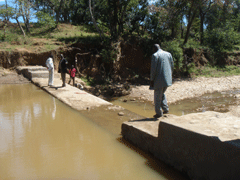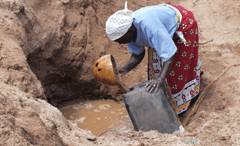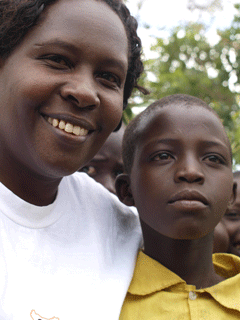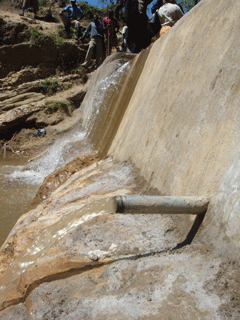Water and Women in Kenya
Air Date: Week of March 20, 2009

Sand dam at Akiriamet village, West Pokot, Kenya: opening ceremony, April 2008 - full from the long rains, before the onslaught of a prolonged drought. (Church World Service)
In much of the developing world, women and girls walk miles each day to find water. One woman from Kenya seeks to change that. Deborah Katina founded the group “Yang’at” or “care” which has partnered with the World Church Service to introduce a simple method of catching water in the rainy season and conserving it for drier times.
Transcript
GELLERMAN: It's Living on Earth, I'm Bruce Gellerman.
Water isn’t only about quenching thirst or growing plants - it’s also a gender issue. In many parts of the developing world finding and carrying water is woman’s work. Water as a gender issue is one focus of the UN World Water Day, observed each year on March 22nd.
Deborah Katina traveled from Kenya to the United States to observe the day. She’s the founder of the organization “Yang’at”. With the help of Church World Service, it’s constructing what are called Sand Dams - low cost reservoirs that helps make clean water available year round.
Hi Ms. Katina welcome to Living on Earth.
KATINA: Hi
GELLERMAN: So what does the name of your organization “Yang’at” mean?
KATINA: Yang’at means care, it means we care about the women and the girls.
GELLERMAN: In what language?
KATINA: Pokot
GELLERMAN: Where is that?
KATINA: In Kenya, Ristivali Province, West Pokot district.
GELLERMAN: Is that where you’re from?
KATINA: Yeah, that’s where I’m from.
GELLERMAN: Well tell me about the Pokot district, particularly in terms of water.
KATINA: Ok the Pokot district, we are nomads, so pastoralists and it’s – most of the area is arid. And people do go long distances especially women and girls, they go long distances in search of water.

Sand dam at Akiriamet village, West Pokot, Kenya: opening ceremony, April 2008 - full from the long rains, before the onslaught of a prolonged drought. (Church World Service)
GELLERMAN: How far?
KATINA: Twenty miles. Round trip.
GELLERMAN: And it’s the women and the girls who do the getting.
KATINA: Yes. The women and the girls do it. Our men just sleep.
GELLERMAN: And your organization CARE, you’re addressing the water problems, I understand.
KATINA: Yes, we’re addressing the water problems, and we’re doing the sand dams and shallow wells.
GELLERMAN: Sand dams. What are sand damns?
KATINA: Sand dams, it’s a – this is a way we block the seasonal river, because we have seasonal rivers there. So it’s a manner of blocking or building a wall across the seasonal river so that when it rains during rainy season or when we have rains we literally catch all the water instead of letting the water flow maybe to another bigger river or somewhere. But we catch all the water and it can be stored in the sand dam, which is beneath the sand, so that it can be reused during dry season. So that people can drink good, clean water.

In Kenya's semi-arid West Pokot district, during droughts when the river bed is dry, women in the village near this sand dam can dig into the sand and retrieve clean water from a sub-surface reservoir. Some villages build shallow wells next to their sand dams, to hold water for human use, leaving a dam-side pool for their cattle. (Henry Coates/Church World Service)
GELLERMAN: So, if I understand this correctly the sand which accumulates on the upstream part of the river …
KATINA: Yes.
GELLERMAN: … acts as a sponge of sorts, right?
KATINA: Yeah.
GELLERMAN: And then, you put a hole in the dam and you get the water that’s stored in the sponge, even when it’s not raining.
KATINA: Yes, yes, yes.
GELLERMAN: And it works?
KATINA: It works. It really works.
GELLERMAN: How well?
KATINA: Because now we have – okay due to climate change now, okay the seasons are changing and we have maybe one rainy season with floods, a lot of floods. And then when we build that wall along the seasonal river, we can have a lot of water stored.
GELLERMAN: So part of the sand dam you turn into a shallow well.
KATINA: Yes.
GELLERMAN: So, how does the shallow well work with the sand dam?

Yang'at's Deborah Katina (left), coordinator of Church World Service-supported water projects in Kenya, and Rosalyn, a top student in one West Pokot community. (Henry Coates/Church World Service)
KATINA: A shallow well will be constructed near a sand dam, because the water now has been stored and there’s water throughout. So the shallow well will be just beside there so that they can have clean water and also we can have a separate cattle trough for the animals.
GELLERMAN: How much does it cost to construct one of these sand dams?
KATINA: Okay, to construct it will need $15,000. We’ve constructed one sand dam with put up shallow well. We’ve put up the cattle trough and also the transport and all the other logistics.
GELLERMAN: You know, Deborah, you’re visiting the United States now.
KATINA: Yes.
GELLERMAN: You can turn the faucet and out comes the water. What is that like for you?
KATINA: It’s luxury. When I see water running, it’s luxury. In fact, even today in the morning I call my brother and the first thing he was complaining about was water – there’s no water. And here I am, there’s plenty of water. I can shower. And even sometimes when I walk I see people just leaving the tap on and it’s like “oh – I wish this water would be taken to Africa to, to place, it would be very nice and luxury.”

Akiriamet residents and Kenyan officials watch water from village’s new sand dam flow down to a cattle pond below. Villagers have built a nearby shallow well at the Akiriamet dam for human water consumption. (Church World Service)
GELLERMAN: Oh, I wanted to ask you: what is the blessing song?
KATINA: It’s sung by people who’ve received something or people who’ve gotten at least the water project and they’re happy and they are blessing those people who contributed something so that they can have water closer to them.
[BLESSING SONG]
GELLERMAN: And that’s sung by girls from your district?
KATINA: Yes, those are the school where we did a sand dam and shallow well, and also besides from sand dam and shallow well we did some latrines and also roof catchment tank. And they’re happy and they’re blessing the people who contributed at least something for them to have water close and then now the diseases, the water born diseases, have been reduced from that area because they can drink clean water and also sanitation issues. So those children are very happy.
GELLERMAN: Can you sing the blessing song?
KATINA: In my language?
GELLERMAN: Yeah. Are you a good singer?
KATINA: [Laughs] I am a good singer. And I can sing one in Kiswahili which says [singing in Kiswahili].
GELLERMAN: What is that?
KATINA: That is blessing. God bless you so much. Be blessed for all what you do.
GELLERMAN: Deborah Katina’s organization is called Yang’at. She’s visiting the United States and she recently won Kenya’s Head of State Commendation Award for her work with the organization that she founded.
Deborah Katina, thanks very much. It was nice talking to you.
Links
Living on Earth wants to hear from you!
Living on Earth
62 Calef Highway, Suite 212
Lee, NH 03861
Telephone: 617-287-4121
E-mail: comments@loe.org
Newsletter [Click here]
Donate to Living on Earth!
Living on Earth is an independent media program and relies entirely on contributions from listeners and institutions supporting public service. Please donate now to preserve an independent environmental voice.
NewsletterLiving on Earth offers a weekly delivery of the show's rundown to your mailbox. Sign up for our newsletter today!
 Sailors For The Sea: Be the change you want to sea.
Sailors For The Sea: Be the change you want to sea.
 The Grantham Foundation for the Protection of the Environment: Committed to protecting and improving the health of the global environment.
The Grantham Foundation for the Protection of the Environment: Committed to protecting and improving the health of the global environment.
 Contribute to Living on Earth and receive, as our gift to you, an archival print of one of Mark Seth Lender's extraordinary wildlife photographs. Follow the link to see Mark's current collection of photographs.
Contribute to Living on Earth and receive, as our gift to you, an archival print of one of Mark Seth Lender's extraordinary wildlife photographs. Follow the link to see Mark's current collection of photographs.
 Buy a signed copy of Mark Seth Lender's book Smeagull the Seagull & support Living on Earth
Buy a signed copy of Mark Seth Lender's book Smeagull the Seagull & support Living on Earth

